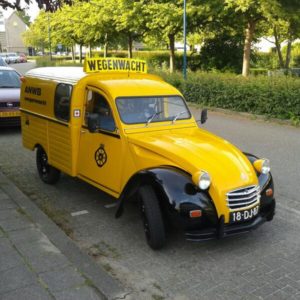The yellow brigade of the ANWB existed on 15 April 2016 70 year and the anniversary was celebrated. The rescuers in pechnood from 1946 have become iconic on our national roads. Nowadays, arriving yellow Volkswagen cars are at least a symbol of hope in car disaster. But from the transitional period between the fifties and sixties, the ANWB used a standard bearer of a completely different kind, which turned out to be almost irreplaceable. Up to and including 2, the 1973 CV was a household name for stranded motorists.
The brave Wegenwacht brigade had used engines exclusively until the end of the 1950s. Successively the Harley Davidson Liberator, a few BSA M-series, the Saroléa and the Wegenwachtscooter were the "open" tools of the road guards. It was time for the road guards to be given more room for tools and comfort during the journeys. In 1959 the Citroën 2 CV tested extensively. In 1960, the 2 CV AZ became the new face of the ANWB Roadside Assistance. The ANWB gave him a painted roof with logo, the familiar yellow Roadside Assistance color and front fenders painted in black.

Evolution
Over the years, the Wegenwacht 2 CV evolved with the factory modifications of Citroën along. Pretty soon the AK350 formed the starting point. A revised grille and relocated mirrors were some of the key highlights. However, the French modifications were not the only basis for the renewal of the “ANWB Besteleenden”. For safety reasons, the 2 CVs of the ANWB were also fitted with a flashing light and a light box. Due to the need for more cargo space, the last two generations of the roadside assistance duck were based on the AK400, the “big” order 2 CV. The last Roadside Assistance Duck had a cargo area with a raised roof. Also striking: large interchangeable signs on the back of the ducks alerted motor vehicle owners to current topics such as “Glass on? Let yourself be driven! ”. Road users were also made aware of the risk of skidding or forest fire through other signs.
Experiments could not replace 2CV
During the Wegenwacht service years of the Besteleend, the ANWB also experimented with other vehicles, whether or not from the point of view of loyal Citroën 2 CV to be replaced. The DAF 33 was ordered in a number of six, but turned out to be literally too light to let the 2 CV go with a roadside assistance pension. Another experiment followed in 1970. The double chevron played a leading role in it, because the Citroën Ami Service was destined to follow the old faithful A-type brother. The plus points of the 2CV were too many, and as a means of recognition the duck was simply too important for the ANWB to thank the 2 CV before 1973 for services rendered. The A-types of meticulously fulfilled Citroën their loyal services.

Renault 4 takes over the torch
In 1973 the marriage was between Citroën and the ANWB passed. Renault took the place of the 2CV at the Wegenwacht. The R4 took over, continued to provide services for a few years with the ducks that were already in use and formed the face of the ANWB Roadside Assistance, which currently maintains an alliance with Volkswagen since 1978.
Beloved in enthusiastic circles
Yet the 2CV is the car that made the Wegenwacht permanent adult. The practical ease of use, the affectionate and reliable 2 cylinders, the cost-efficient use and the unique properties of the 2 CV ensure that the Roadside Duck still enjoys a popular status to this day. The important means of transport in the history of the yellow brigade is still cherished or recreated by various hobbyists today. And for those who love miniatures, it is good to know that the Roadside Duck can be ordered via the ANWB website.
Source: Roadside assistance
Edited: Auto Motor Klassiek/ Erik van Putten


